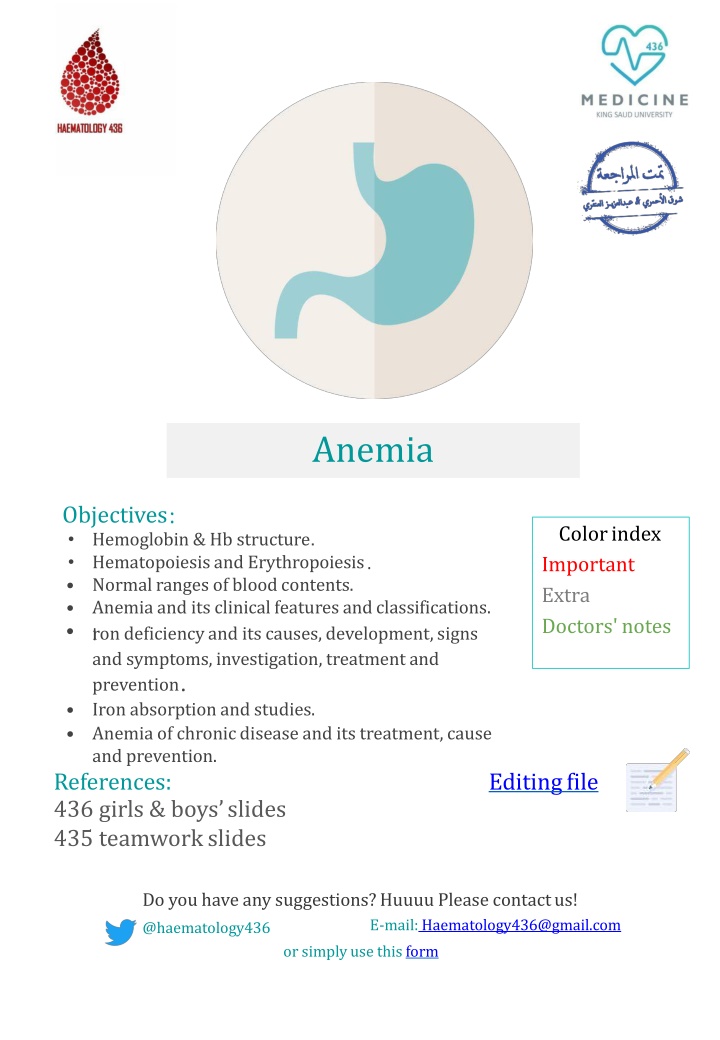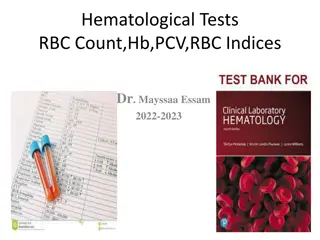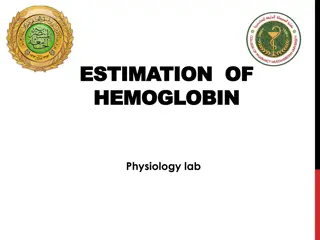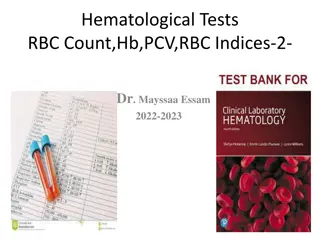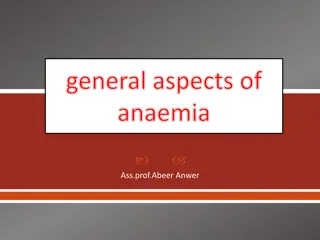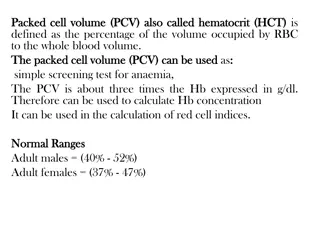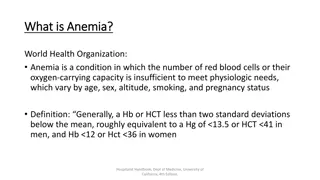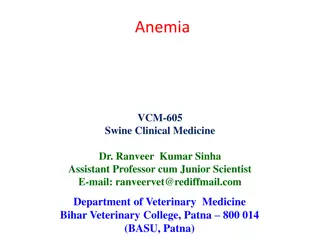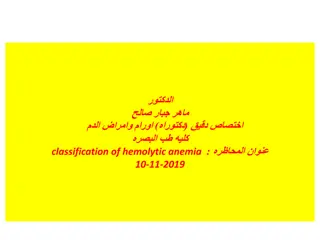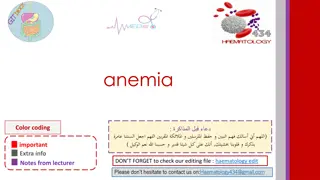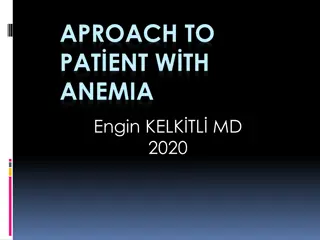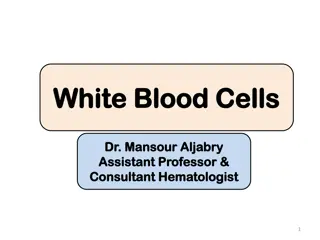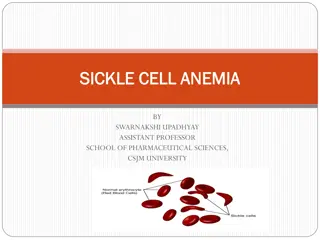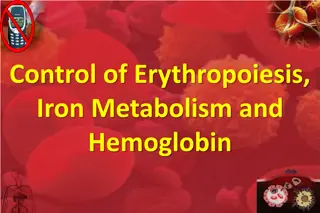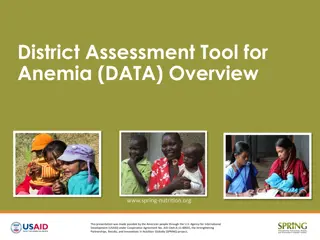Anemia: Hemoglobin Structure, Hematopoiesis, and Clinical Features
Anemia involves a decrease in hemoglobin levels, impacting oxygen transport and tissue oxygenation. Learn about hematopoiesis, erythropoiesis, normal blood ranges, iron deficiency anemia, anemia of chronic disease, and clinical manifestations. Explore the importance of hemoglobin, erythropoietin, and iron absorption in managing anemia. Uncover the various classifications, causes, symptoms, investigations, treatments, and prevention strategies for different types of anemia.
Download Presentation

Please find below an Image/Link to download the presentation.
The content on the website is provided AS IS for your information and personal use only. It may not be sold, licensed, or shared on other websites without obtaining consent from the author.If you encounter any issues during the download, it is possible that the publisher has removed the file from their server.
You are allowed to download the files provided on this website for personal or commercial use, subject to the condition that they are used lawfully. All files are the property of their respective owners.
The content on the website is provided AS IS for your information and personal use only. It may not be sold, licensed, or shared on other websites without obtaining consent from the author.
E N D
Presentation Transcript
Anemia Objectives Hemoglobin & Hb structure. Hematopoiesis and Erythropoiesis Normal ranges of bloodcontents. Anemia and its clinical features andclassifications. ron deficiency and its causes, development, signs and symptoms, investigation, treatment and prevention Iron absorption and studies. Anemia of chronic disease and its treatment, cause and prevention. References: 436 girls & boys slides 435 teamworkslides Colorindex Important Extra Doctors'notes Editingfile Do you have any suggestions? Huuuu Please contactus! @haematology436 or simply use thisform E-mail:Haematology436@gmail.com
Hemoglobin Male: Hemoglobin= Heme (iron) + globin chain (alpha , beta ,delta.etc) Hemoglobin is the protein molecule in RBC that carries O2 from the lungs to the body's tissues and returns carbon CO2 from the tissues back to the lungs. Male: Max. Capacity of hemoglobin to carry o2 Is 4 molecules of oxygen per 1 hemoglobin Hemoglobin maintains the shape of RBC also. Hemoglobinstructure Hematopoiesis: is the production of all of the cellular components of blood and bloodplasma. Hematopoieticstem cell:Male:Will give me all types of blood cells (RBCs,WBCs,Plateletsetc.) 1 Self renewalMale: when there is problems in self renewal there will be deficiency of Hematopoietic stem cells will lead to aplastic anemia (will not have RBCs, Neutrophils, platelets.Etc.) 2 Cell differentiation Male: It make other typesof blood cells like (myeloid sc ,etc.). Which are functionalTypes Erythropoietin= secreted fromkidneys It controls celldifferentiation. Erythropoietin: It is like the cable that pull Hematopoietic stem cell toward the RBCs production so deficiency of it especially in renal diseases ( because it produces in kidneys ) will lead to deficiency of RBCsalso. Erythropoiesis:Production ofRBCs The Bone Marrow is the major site of erythropoiesis with the need of: Folic acid Iron Ferrous Vit B12 Erythropoietin - Amino acids, minerals - other regulatory factors in bone marrow in circulation Male: Most hemoglobins are synthesized here
NormalRanges it is very important to know the age and thesex Indices Female Male Hemoglobin(g/dL) 11.5-15.5 13.5-17.5 Hematocrit (PCV) (%)also called HCT : percentage of RBCs in the tube of wholeblood 36-48 40-52 Red Cell Count( 10 ) 3.9-5.6 4.5-6.5 Mean Cell Volume (MCV) (fL) Average size of average RBC,if MCV<80 the it is microcell anemia ,if MCV>95 then it is macrocytic anemia. 80-95 Mean Cell Hemoglobin (MCH) (pg) Hemoglobin inside eachRBCs 30-35 There is noHyper-chromic Anemia An (without) -emia (blood): Reduction of Hb concentration belowthe normal range for the age and gender. Leading to decreased O2 carrying capacity of blood and thus O2 availability to tissues(hypoxia) Male notes: Our body detect the anemia to start compensatory mechanisms not by calculating the Hemoglobin concentration. It detect it by detect the hypoxia, then it will send messages by the erythropoietin signals that generate from kidney to bone marrow to synthesis more RBCs & Hemoglobin. Presence or absence of clinical feature dependson: 1Speed of onset: Rapidly progressive anemia causes more symptoms than slow onset anemia due to lack of compensatory mechanisms: (cardiovascular system Can lead to congestive heart failure , BM &O2 dissociation curve) 2Severity: Mild anemia > no symptoms usually Symptoms appear if Hb less than 9g/dL 3 Age: Elderly tolerate anemia less than young patients.less compensation than young.
Clinical Features: 1-General features ofanemia: - Weakness -Headache -Pallor-Lethargy -Dizziness related to anemia - Palpitation (tachycardia) -Angina -Cardiac failure Related tocompensatory mechanism. 2-Specific features: *important Specific signs are associated with particular types of anemia: Spoon nail = iron deficiency Leg ulcers = sickle cell anemia Jaundice = hemolyticanemia Bone deformities = thalassemia major Classification ofAnemia HypochromicMicrocytic Anemia Any deficiency of the contents lead to this type ofanemia. site= Hb MacrocyticAnemia site= DNAsynthesis Structure affected: 1.porphyrin: Sideroblasticanemia 2. Iron : iron deficiencyanemia 3. Globin Chain:Thalassemia Thalassemia: Reduction of production of normal globinchain Megaloblastic anemia due to : Which havemajor role in DNA synthesis & repairing. 1.Vit B12deficiency. 2. Folatedeficiency. 3. Myelodysplasticsyndrome(MDS) Normocytic NormochromicAnemia Blood loss: acute bleeding. hemolysis Destruction of RBCs inside the vessels : ( autoimmune, enzymopathy, membranopathy, mechanical , sickle cell anemia). RBC production ( Bone marrow failure ): chemotherapy. malignancy. Aplastic anemia. Hematopoietic stem cell Deficiency and here we have bone marrow shut down anemia of chronicdisease. 1. 2. 3. the most popular types of anemia are the iron deficiency anemia and the megaloblasticanemia
Iron DeficiencyAnemia: Male: Why ? Because the Iron itself is very toxic for the body, accumulation increased Iron absorption for example may lead to Hemochromatosis may lead to deficiency of many glands and leads to diseaseslike diabetes. iron deficiency anemia Iron is among the abundant minerals on earth(6%). and due its to Iron deficiency is the most common disorder(24%). Limited absorption ability : which 1-Only 5-10% of taken iron will be absorbed. 2- Inorganic iron can not be absorbedeasily. Excess loss due to hemorrhage The Storage of the Iron in our bodies is in the Macrophages Transferrin: is Iron transport protein. each transferrin carry 2 molecules of iron. All Iron that carried by transferrin goes to Bone marrow to synthesize the Hemoglobin. bone marrow Haem iron is directly absorbed without need of any enzymes through HCP-1 Absorbable activeform Non-absorbable inactive form In organic (non-heme) Iron needs to one additional step to absorb which is converted the Fe3+ form (Ferric iron) which is non-absorbable form to the Fe2+ form (Ferrous Iron) which is absorbableform , by enzyme Ferrireductase. Hepcidin is the master thatcontrol Iron absorption called Duodenal cell At absorbed will export to the plasma through where we control the Iron absorption indirectly Hepcidin in the control Ferroportin negative feedback control. the end all Iron that High hepcidin = low absorption of Iron Low hepcidin = high absorption ofIron Ferroportin by liver that by Hepcidin not only has negative effect on the absorption of the Iron , it also has the same effect at Ferroportin of macrophages ( macrophages are where the Iron stores) During through converted again to inactive form (Fe3+) which is the Irons storage form and then it took by transferrin. the iron passage Ferroportin it To synthesize Hemoglobin Bonemarrow
Factors Affecting iron absorption only in Female slides (same as the table): 1- Iron bodystatus: Increased demands (iron def., pregnancy) low iron stores (increase release) highabsorption. Iron overload full iron stores low absorption. 2- Content and form of dietaryiron: More iron, Haem iron and Ferrous iron Moreabsorption. 3- GIT mucosa: Disruption of GIT mucosa cannot absorbiron. 4- Balance between dietary enhancers and Inhibitoryfactors: Enhancers: Meat (haem iron), fruit (Vit-C), sugar (solubilizing agent),and acids. You can combine orange juice with meat to enhance ironabsorption. Inhibitory: Dairy foods (calcium), high fiber foods (phytate), coffee and tea (polyphenols), and anti-acids(Alkalines).
Causes of iron DeficiencyAnemia: 2-Increased demands: Immaturity Growth Pregnancy EPOtherapy 1-Chronic bloodloss: Male: Majorcause GIT Bleeding: peptic ulcer, esophageal varices , hookworm& cancer Uterinebleeding Hematuria 3-Malabsorption: Enteropathy (GITproblems) Gastrectomy 4-Poor diet: Rare as the only cause (rule out other causes) If the patient not supplemented withIron Development ofIDA: 1 2 3 4 Iron def. anemia (signs ofanemia) Normal Pre-latent Latent Stores Normal Low Low Low MCV/MCH Normal Normal Low Low Hemoglobin Normal Normal Normal Low Signs and symptoms of IDA: Beside symptoms and signs of anaemia +/- bleeding patients present with: (a): Koilonychia (spoon-shapednails) (b): Angular stomatitis and/or glossitis (c): Dysphagia due to pharyngeal web (Plummer-Vinsonsyndrome)
Investigations: 1.Microcytichypochromic anemia with: Anisocytosis (variation in size) Poikilocytosis (variationin shape). 2.Bone marrow Ironstain (Perl sstain): The gold standard but invasive procedure. Normal IronStudies: important Because reduction of the Iron but, because of reduction of production of globin chain, so there will be a lot of Iron without any function (cannot bind to globin chain and form hemoglobin.) the problem here is not in the There is a lot of Freetransferrin which is iron transport protein because of less amount of Iron. . (Iron = ) Serum ferritin= ironstore
Treatment of IDA -Treat the underlyingcause -Iron replacement therapy: Oral (Ferrous Sulphate OD for 6 months) -Intravenous (Ferric sucrose OD for 6 months) -Hb should rise 2g/dL every 3 weeks. Prevention Of IDA: -Dietary modification Meat is better source than vegetables. -Food fortification (with ferroussulphate) -GIT disturbances, staining of teeth & metallictaste. -Iron supplementation: For high riskgroups. Anemia of chronic disease: -Normochromic normocytic (usually) anemia caused by decreased release of iron from iron stores and reduction of iron absorption due to raised serumHepcidin. -Associated with - Chronic infection including HIV, malaria - Chronic inflammations -Tissue necrosis-Malignancy these diseases causeincreased synthesis of hepcidin. When hepcidin increase the absorption of Iron and release of the iron from Macrophages will decrease.
Work-up and treatment: -Normocytic normochromic or mildly microcyticanaemia Findings:- -Low serum iron and TIBC -Normal or high serum ferritin ( acute phasereactant) -High haemosiderin in macrophages but low in normoblasts. -Management: Treat the underlying cause Iron replacement +/- EPO (erythropoietin) Summary Clinical Features: Presence or absence of clinical feature dependson: 1Speed of onset: Anemia: Reduction of Hb concentration below the normal range for the age and gender.Leading to decreased O2 carrying capacity of blood and thus O2 availability to tissues(hypoxia) 2Severity:Symptoms appear if Hb less than 9g/dL 3-Age ClinicalFeatures Weakness, Headache, Pallor, Lethargy,Dizziness, Palpitation (tachycardia), Angina, Cardiacfailure 2-Specificfeatures Specific signs are associated with particular typesof anemia : *Spoon nail with iron deficiency, *Leg ulcers with sickle cellanemia *Jaundice with hemolyticanemia * bone deformities in thalassemiamajor Classification of Anemia: Hypochromic microcyticanemia: Related to hemoglobin due toporphyrin,iron,globin chainproblems. Macrocytic anemia: Related to DNA synthesis Normocytic normochromicanemia: Related to bloodcount Iron Deficiency Anemia: the mostcommon disorder(24%). Limited absorptionability Excess bloodloss Iron Absorption: Dependson: 1Body Ironstatus: 2 Content and form of dietaryiron 3Balance between dietary enhancers & Inhibitoryfactors Treatment ofIDA Treat the underlyingcause Iron replacementtherapy: Factors favoringabsorption Haem iron, Ferrous iron, Acid, Iron def., Pregnancy, Hemochromatosis, Solubilizingagents Factor reducingabsorption Inorganic iron, Ferric iron, Alklines, Iron overload, Tea, Increased hepcidin, Precipitating agent Causes of IDA 1-Chronic bloodloss: 2- Increaseddemands: 3-Malabsorption 4-Poordiet PREVENTION OFIDA Dietarymodification Food fortification (with ferroussulphate) Ironsupplementation:
:MCQs 1- Which one of the following consider as the major factor that control Iron absorption and release? A- Vit.B12 C-Ferrireductase B-Hepcidin D- PrecipitatingAgent Answer:B 2- The gold standard for investigating IDAis: A- H&E stain C- Zheel Neelsenstain B-Perl sstain D- PAS Answer:B 3-The cause of Megaloblastic Anemia is deficiencyof: A- Vit B6 C- VitB12 B-Vit A D- VitE Answer:C 4- Normochromic normocytic is associatedwith: B-HIV D- Poordiet A-Pregnancy C- Bloodloss Answer:B 5- Which ONE of the following consider As transcriptional factors that have a role in cell differentiation from Hematopoietic stem cell: A-GATA1 C-Hepcidin B-MyeloidCells D- None of theabove Answer:A GoodLuck! Teammembers Girls: Rana Barasain Wejdan Alzaid Reema AlOtaibi AshwaqAlmajed TeamLeaders SafaAlOsaimi AbdulazizAl-Hussainy
